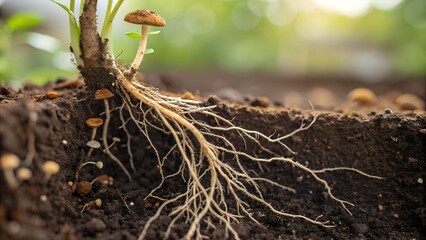SYLLABUS
GS-3: Environmental Conservation
Context: Recently, the Underground Atlas by Society for the Protection of Underground Networks (SPUN) revealed that over 90 per cent of mycorrhizal fungi hotspots are outside protected areas.
More on the News
- SPUN’s Underground Atlas is the first digital map predicting Earth’s underground mycorrhizal fungal biodiversity and endemism patterns.
- Underground Atlas explore the distribution of arbuscular mycorrhizal (AM) and ectomycorrhizal (EcM) fungi to identify biodiversity hotspots and areas with rare, endemic fungi.
- Using 25,000 soil samples from 130 countries, the atlas predicts areas of fungal richness and endemism through machine-learning models based on 2.8 billion DNA sequences.
- Key hotspots include:
- AM fungi (arbuscular mycorrhizal fungi): Brazilian Cerrado, Southeast Asian tropical forests, and Guinean forests.
- EcM fungi (ectomycorrhizal fungi): Siberia, Canadian boreal forests, Western US coniferous forests, and European mixed forests.
Mycorrhiza fungi

- Mycorrhizal fungi are a group of network-forming soil fungi that form symbiotic associations with plants.
- Mycorrhiza is a symbiotic association between fungi and plant roots that literally means fungal root.
- Symbiotic relationships between plants and mycorrhizal fungi are around 475 million years old and play fundamental roles in the Earth’s biosphere.
- This relationship is mutually beneficial:
- The plant provides carbohydrates (like sugars) to the fungus.
- The fungus enhances water and nutrient absorption for the plant.
Mycorrhizal Fungi’s Role in Plants
- Enhances nutrient and water absorption by extending the root system, especially aiding in the uptake of phosphorus, nitrogen and other micronutrients and improving drought resistance.
- Strengthens plant health by boosting immunity against soil-borne diseases and promoting robust root growth and branching.
- Supports soil and environmental health by improving soil structure and reducing dependence on chemical fertilizers, promoting sustainable agriculture.
Importance of Mycorrhizal Fungi
- Climate Regulation: Mycorrhizal fungi help regulate Earth’s climate by forming underground networks that pull around 13 billion tons of CO₂ into soils each year.
- Carbon moved into soil by fungi stays longer than carbon from sources like fallen leaves.
- Ecosystem Support: These fungi support biodiversity from rainforests to tundra by forming the base of food webs.
- They feed plants and protect them from drought, salinity, pathogens, metal toxicity and herbivores.
- Nutrient Transport: Fungal networks can extend up to 100 times longer than plant roots and efficiently extract and transport nutrients like phosphorus across ecosystems.
Key Threats to Mycorrhizal Fungi
- Habitat Destruction: Habitat loss from logging, farming and urbanization disrupts underground fungal networks. Without plants, mycorrhizal fungi cannot survive.
- Damaged networks lose their ability to store carbon, move nutrients and support soil health.
- Agricultural expansion: Industrial farming harms fungi through tillage, fertilizers and pesticides. This weakens crops, making them more dependent on chemicals and more vulnerable to drought, erosion, pests and disease.
- Climate disruption: Extreme weather and wildfires damage fungi and plants. Climate change reduces fungi’s ability to transport nutrients and store carbon underground.
About Society for the Protection of Underground Networks (SPUN)
- SPUN founded in 2021 is a science-based initiative focused on mapping and protecting the mycorrhizal networks that play a crucial role in regulating Earth’s climate and ecosystems.
- SPUN aims to build the most comprehensive atlas of Earth’s mycorrhizal biodiversity, scaling and accelerating the speed of science around mycorrhizal fungi.
- SPUN is headquartered in Dover, Delaware, USA.

Source
https://www.spun.earth/networks/threats
https://www.spun.earth/underground-atlas/mycorrhizal-biodiversity

